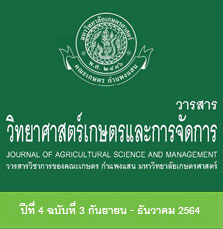ผลของสารสกัดจากพืชบางชนิดต่อหนอนกระทู้ผัก
คำสำคัญ:
สารสกัดจากพืช, หนอนกระทู้ผักบทคัดย่อ
พืชหลายชนิดมีคุณสมบัติเป็นสารฆ่าแมลงสามารถใช้ควบคุมแมลงศัตรูผักในระบบเกษตรอินทรีย์ได้เนื่องจากเป็นสิ่งที่ได้จากธรรมชาติ ดังนั้นจึงได้ทำการศึกษาผลของสารสกัดจากพืชบางชนิดต่อหนอนกระทู้ผัก ซึ่งจัดเป็นหนึ่งในแมลงศัตรูสำคัญของพืชผักกะหล่ำ โดยมีวัตถุประสงค์เพื่อคัดเลือกสารสกัดจากพืช 10 ชนิดคือ สะเดา (Azadirachta sp.) ยาสูบ (Nicotiana sp.) ยูคาลิปตัส (Eucalyptus sp.) ตะไคร้หอม (Cymbopogon nadus) มะกรูด (Citrus hystrix) หนอนตายหยาก (Stemona sp.) ผกากรอง (Lantana sp.) หางไหล (Derris sp.) ว่านน้ำ (Acorus sp.) และสาบเสือ (Chromolaena sp.) สำหรับควบคุมหนอนกระทู้ผักวัยที่ 3 โดยสกัดพืชด้วยเทคนิคการแช่พืชในตัวทำละลายแอลกอฮอล์อัตรา 1:5 w/v เป็นระยะเวลา 5 วัน ระเหยแอลกอฮอล์ออกจนได้สารสกัดพืชเข้มข้นร้อยละ 100 จากนั้นปรับความเข้มข้นที่ร้อยละ 5 เพื่อใช้ทดสอบคัดเลือกสารสกัดจากพืชที่มีประสิทธิภาพสูงสุด จากนั้นศึกษาความเป็นพิษของสารสกัดที่ผ่านการคัดเลือกอีกครั้งกับหนอนกระทู้ผัก ผลการศึกษาพบว่า สารสกัดจากพืชทั้ง 10 ชนิดมีผลต่อการตายของแมลงศัตรูผักแตกต่างจากไม่พ่นสารอย่างชัดเจนที่ 48 ชั่วโมงหลังพ่นสาร โดยสารสกัดจากยูคาลิปตัสมีประสิทธิภาพสูงสุด โดยทำให้หนอนกระทู้ผักตายร้อยละ 78.3 ที่ 48 ชั่วโมงหลังได้รับสาร มีระยะเวลาที่ทำให้แมลงตายร้อยละ 50 (LT50) ที่ 16.82 ชั่วโมงหลังสัมผัสสาร มีระดับความเป็นพิษของสารสกัดจากค่าความเข้มข้นของสารที่ทำให้หนอนกระทู้ผักตายร้อยละ 50 (LC50) ที่ ร้อยละ 3.39 ที่ 24 ชั่วโมงหลังสัมผัสสาร
เอกสารอ้างอิง
เกษม ตั้นสุวรรณ และ สุธิตา ตั้นสุวรรณ. 2543. เปรียบเทียบผลของสารสกัดจากพืชบางชนิดต่อหนอนกระทู้ผัก. ภาควิชาเคมี คณะวิทยาศาสตร์ มหาวิทยาลัยทักษิณ, สงขลา.
ขวัญชัย สมบัติศิริ. 2555. การใช้สารสกัดจากเมล็ดสะเดาป้องกันกำจัดแมลง. ภาควิชากีฏวิทยา คณะเกษตร, มหาวิทยาลัยเกษตรศาสตร์, กรุงเทพฯ.
คณิตา ทองเจริญ วีรเทพ พงษ์ประเสริฐ ไสว บูรณพานิชพันธุ์ และจิราพร ตยุติวุฒิกุล. 2552. ประสิทธิภาพของสารฆ่าแมลงบางชนิดที่มีต่อหนอนใยผักในเขตภาคเหนือตอนล่างของประเทศไทย. วารสารเกษตร 25(3): 245-255.
จอมสุรางค์ ดวงธิสาร, วีรเทพ พงษ์ประเสริฐ, ไสว บูรณพานิชพันธุ์ และจิราพร ตยุติวุฒิกุล. 2551. ความต้านทานของด้วงหมัดผักแถบลายในเขตภาคเหนือตอนล่างที่มีต่อสารฆ่าแมลงบางชนิด. วิทยาสารกำแพงแสน สาขาพืช 6(2):15-26.
ต.ชาตรี. 2553. สมุนไพรเพื่อการเกษตรสำหรับการป้องการ และกำจัดศัตรูพืช, สำนักพิมพ์นีออนบุ๊คมีเดีย, กรุงเทพฯ
นิสา เกลี้ยงเกลา, ปภพ สินชยกุล, วิชัย สรพงษ์ไพศาล และ อารยา บุญศักดิ์. 2563. ชนิดของเพลี้ยไฟในกุหลาบและการควบคุมโดยใช้สารสกัดจากพืช. วารสารวิทยาศาสตร์เกษตรและการจัดการ 3(3), 78-89.
รัตติยา นวลหล้า และ พิทยา สรวมศิริ. 2542. การคัดเลือกสมุนไพรป้องกันกำจัดหนอนกระทู้ผัก. วารสารเกษตร 15(2): 192-202.
วาสนา ไชยคํา. 2545. ฤทธิ์ฆ่าแมลงของสารสกัดจากหนอนตายหยาก (Stemona spp.) และเถาวัลย์เปรียง (Derris scandens Benth.). วิทยานิพนธ์ปริญญาโท, มหาวิทยาลัยขอนแก่น, ขอนแก่น.
สุเทพ สหายา และ ลักขณา บำรุงศรี. 2546. โรติโนนสารสกัดจากพืชที่มีพิษต่อแมลง. วารสารกีฏและสัตววิทยา 25(4): 295 – 298.
สุภาณี พิมพ์สมาน, รัตนาภรณ์ พรหมศรัทธา และสังวาลย์ สมบูรณ์. 2546. สารสกัดจากหนอนตายหยาก (Stemona sp.) เพื่อการควบคุมแมลงศัตรูพืช ใน การประชุมวิชาการอารักขาพืชแห่งชาติครั้งที่ 6 ณ.โรงแรมโซฟิเทลราชาออคิดขอนแก่น วันที่ 24-27 พฤศจิกายน 2546. หน้า 22.
อำนวย อิศรางกูร ณ อยุธยา. 2535. การใช้สารสกัดจากพืชควบคุมแมลงศัตรูพืช. วารสารเกษตรก้าวหน้า 7(4): 25–35.
อุดมพร แพ่งนคร. 2528. ประสิทธิภาพของสารสกัดสะเดาที่มีต่อหนอนกระทู้หอม Spodoptera exigua Hubner และหนอนกระทู้ผัก Spodoptera litura (F.). วิทยานิพนธ์ปริญญาโทมหาวิทยาลัยเกษตรศาสตร์, กรุงเทพฯ.
Bakkali, F., S. Averbeck, D. Averbeck and M. Idaomar. 2008. Biological effects of essential oils-A review. Food Chemical Toxicology 46: 446–75.
Batish, D.R., H.P. Singh, N. Setia, S. Kaur and R.K. Kohli. 2006. Chemical composition and phytotoxicity of volatile essential oils from intact and fallen leaves of Eucalyptus citriodora. Zeitschrift für Naturforschung Online c61: 465–471.
Bomford, M.K. and M.B. Isman. 1996. Desensitization of fifth instar Spodoptera litura (Lepidoptera: Noctuidae) to azadirachtin and neem. Entomologia Experimentalis et Applicata 81: 307–313.
Brooker, M.I.H. and D.A. Kleinig. 2006. Field guide to Eucalyptus. vol.1. South-eastern Australia, Third edition. Bloomings, Melbourne.
Chauhan, D. and V. K. Mishra. 2016. Effect of medicinal plant extracts on growth and development of tobacco caterpillar, Spodoptera litura (Fabricius). International Journal of Agriculture, Environment and Biotechnology 9(3): 435-442.
Cheraghi Niroumand, M., M.H. Farzaei, E. Karimpour Razkenari, G. Amin, M. Khanavi, T. Akbarzadeh and M.R. Shams-Ardekani. 2016. An evidence-based review on medicinal plants used as insecticide and insect repellent in traditional Iranian medicine. Iranian Red Crescent Medical Journal 18(2): 1-8 (e22361). doi: 10.5812/ircmj.22361. PMID: 27186389; PMCID: PMC4867175.
Duke, J.A. 2004. Dr. Duke’s Phytochemical and Ethnobotanical databases. Available online at http://www.ars-grin.gov/duke/ (accessed on 9 June, 2008).
Jiwajinda, S., N. Hirai, K. Watanabe, V. Santisopasri, N. Chuengsamarnyart, K. Koshimizu and H. Ohigashi. 2001. Occurrence of the insecticidal 16, 17-didehydro-16 E)-stemofoline in Stemona collinsae. Phytochemistry 56: 693-695
Kraiwit Ruangsuk, Pabhop Sinchayakul, Weerathep Pongprasert and Wichai Sorapongpaisal. 2019. Variation of neem seed morphology and azadirachtin content in different climatic zones of Thailand. International Journal of Biosciences 14(5): 330-342.
Lee, G., J.C. Hall and J.H. Park. 2002. Doublesex gene expression in the central nervous system of Drosophila melanogaster. Journal of Neurogenetics. 16(4): 229-248.
Li, H., J.L. Madden and B.M. Potts. 1996. Variation in volatile leaf oils of the Tasmanian Eucalyptus species II. Subgenus Symphyomyrtus. Biochemical Systematics and Ecology 24: 547– 569.
Liu, X., Q. Chen, Z. Wang, L. Xie and Z. Xu. 2008. Allelopathic effects of essential oil from Eucalyptus grandis, E. urophylla on pathogenic fungi and pest insects. Frontiers of Forestry in China 3: 232–236.
Loh, F.S., R.M. Awang, D. Omar and M. Rahmani. 2011. Insecticidal properties of Citrus hystrix DC leaves essential oil against Spodoptera litura fabricius. Journal of Medicinal Plants Research 5(16): 3739-3744.
Mumcuoglu, K.Y., R. Galun, U. Bach, J. Miller and S. Magdassi. 1996. Repellency of essential oils and their components to the human body louse, Pediculus humanus humanus. Entomologia Experimentalis et Applicata 78: 309-314.
Naunla, R. 1999. Application of medicinal plant crude extract for insect control in Chinese kale. M.S. thesis. Chiang Mai University, Chiang Mai.
Omara, T., K. Fredrick, M. Bashir, K. Erisa and K. Sarah. 2018. Bioinsecticidal activity of eucalyptol and 1R-alpha-pinene rich acetonic oils of Eucalyptus saligna on Sitophilus zeamais Motschulsky, 1855 (Coleoptera: Curculionidae). Journal of Health and Environmental Research 4(4):153-160.
Rajendran, S. and V. Sriranjini. 2008. Plant products as fumigants for stored-product insect control. Journal of Stored Products and Resources 44: 126–35.
Su, Y.C., C.L. Ho, I.C. Wang and S.T. Chang. 2006. Antifungal activities and chemical compositions of essential oils from leaves of four eucalypts. Taiwan Journal of Forest Science 21: 49–61.
Tripathi, A.K., S. Upadhyay, M. Bhuiyan and P.R. Bhattacharya. 2009. A review on prospects of essential oils as biopesticide in insect-pest management. Journal of Pharmacognosy and Phytotherapy 1:52-63.
Watanabe, K., Y. Shono, A. Kakimizu, A. Okada, N. Matsuo, A. Satoh and H. Nishimura. 1993. New mosquito repellent from Eucalyptus camaldulensis. Journal of Agricultural and Food Chemistry 41: 2164–2166.
Zunino, M.P., V.A. Areco and J.A. Zygadlo. 2012. Insecticidal activity of three essential oils against two new important soybean pests: Sternechus pinguis (Fabricius) and Rhyssomatus subtilis Fiedler (Coleoptera: Curculionidae). Boletin Latinoamericano y del Caribe de Plantas Medicinales y Aromaticas 11(3):269-277.






